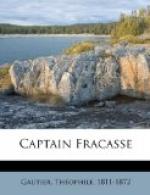After having made every arrangement for Isabelle’s safety, de Sigognac and his companion sallied forth into the Rue Dauphine, and turned towards the Pont-Neuf. It was quickly reached, and when they had taken a few steps upon it a magnificent view suddenly burst upon them, which held the young baron enthralled. In the immediate foreground, on the bridge itself, which was not encumbered with a double row of houses, like the Pont au Change and the Pont Saint Michel, was the fine equestrian statue of that great and good king, Henri IV, rivalling in its calm majesty the famous one of Marcus Aurelius, on the Capitoline Hill at Rome. A high railing, richly gilded, protected its pedestal from injury by mischievous street arabs, and the deep, strong tints of the bronze horse and rider stood out vigorously against the appropriate background formed by the distant hill-sides beyond the Pont Rouge. On the left bank of the river the spire of the venerable old church of Saint Germain des Pres pointed upwards from amid the houses that completely hemmed it in, and the lofty roof of the unfinished Hotel de Nevers towered conspicuously above all its surroundings. A little farther on was the only tower still standing of the famous, and infamous, Hotel de Nesle, its base bathed by the river, and though it was in a ruinous condition it still lifted itself up proudly above the adjacent buildings. Beyond it lay the marshy Grenouillere, and in the blue, hazy distance could be distinguished the three crosses on the heights of Calvary, or Mont-Valerien. The palace of the Louvre occupied the other bank right royally, lighted up by the brilliant winter sunshine, which brought out finely all the marvellous details of its rich and elaborate ornamentation. The long gallery connecting it with the Tuileries, which enabled the monarch to pass freely from his city palace to his country house, especially challenged their admiration; with its magnificent sculptures, its historical bas-reliefs and ornamented cornices, its fretted stonework, fine columns and pilasters, it rivalled the renowned triumphs of the best Greek and Roman architects. Beyond the gardens of the Tuileries, where the city ended, stood the Porte de la Conference, and along the river bank, outside of it, were the trees of Cours-la-Reine, the favourite promenade of the fashionable world, which was thronged of an afternoon with gay and luxurious equipages. The two banks, which we have thus hastily sketched, framed in the most animated scene imaginable; the river being covered with boats of all sorts and descriptions, coming and going, crossing and recrossing, while at the quay, beside the Louvre, lay the royal barges, rich with carving and gilding, and gay with bright-coloured awnings, and near at hand rose the historic towers of Saint Germain l’Auxerrois.




